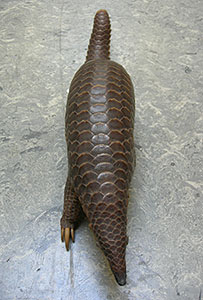Morphology
Pangolins are difficult to confuse with any other mammal. The majority of the dorsal surface is covered by hard, moveable, overlapping scales, olive brown to yellow in colour, giving the appearance of a ‘living pine cone’ or artichoke (Nowak, 1999).
Scales
In M. javanica, scales are absent on the snout tip, ventral and lateral regions of the face, the throat and ventral surface of torso. The tough skin of the scale-less regions is greyish with blue/pink tinge.

The Manis javanica body is elongated and tapers at the conical head and the long, prehensile tail.
The scales grow from the skin and are of similar construction to rhino horn, being formed of hairs cemented together. There are 3-4 hairs between scales. The hairs are pale brown to white.
The posterior edges of the scales are sharp and ridged however the shape and surface of the scales alters with wear.
Body
The body is elongated and tapers at the conical head and the long, prehensile tail. The ratio of tail length to total length is more than 0.42
There are 30 tail scales and a smooth, well-developed glandular pad on the ventral surface of the tail tip. The ears are reduced to ridges and a nictitating membrane is present on the eyes. The conical skull is very simple in form and toothless, with nostrils located at the tip.
Tongue
The tongue is extensively adapted for feeding. It is long (approximately 50% of head & body length), 5mm thick and can be extended 250mm. Within the stomach, the tongue is encased in a sheath, supported by cartilage rods. The tongue muscles are anchored to the pelvis.
Claws
Pangolins are pentadactylous with long, powerful claws on each foot and short, stocky legs. The claws on the forefeet of M.javanica are not longer than 1.5 times those of the hind feet. The longest claw is on the middle digit. The skin on the feet is granular, with pads on the forefeet. The hind feet are plantigrade (Lekagul, 1988).